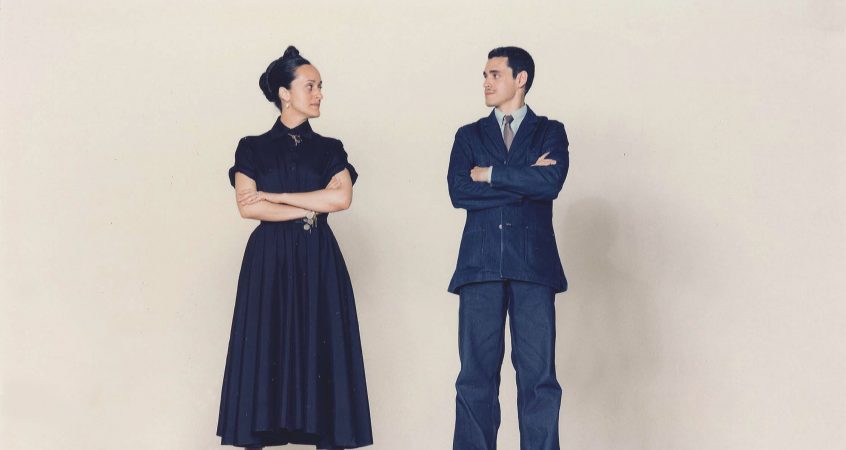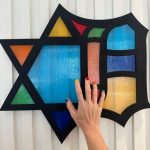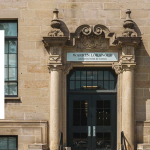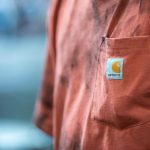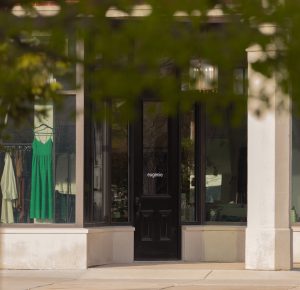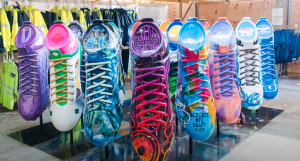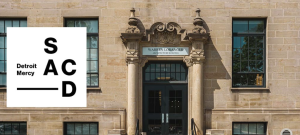If you’ve never heard of artists Isabel and Ruben Toledo, here are two facts and a myth to draw you in:
- They worked with Warhol.
- Isabel designed Michelle Obama’s inauguration outfit.
- They are rumored not to have mobile phones. Or a couch.
That’s real, but keep reading for the real real.
Things to know:
- This entire conversation was written in caps. Not because they are cruel but because they know words are powerful and they intuitively intended (I believe) the long transcription process to be the casting of a spell.
- The DIA recently gave them carte blanche with their permanent collection. The result is Labor of Love, an unprecedented winding installation that is part memoir, social critique and ode to Frida Kahlo & Diego Rivera, the museum itself, the City of Detroit, and the Universe at large.
- Karl Lagerfeld took the photo of them. RIP.
- Labor of Love was curated by Laurie Farrel. If you enjoy the show, write the museum to thank her. Words are powerful, and everyone enjoys a handwritten letter.
What was it like to work with the Toledos? A mini interview.
DIA Director, Salvatore Pons, describes his experience working with the couple.
“I’m particularly grateful for the work they did with Sew Great Detroit, a program of Alternatives for Girls.”
CV Henriette: How did Labor of Love come into being?
Salvator Pons: The Toledos visited the museum a couple of years ago to participate in a program here with Andre Leon Talley. Ruben and Isabel were greatly inspired by Diego Rivera’s Detroit Industry murals, along with the rest of the museum’s collection. For our part, we were looking for an exhibition to follow “Star Wars and the Power of Costume,” so the fact that their work crosses both art and fashion was an ideal way to continue the themes we explored in Star Wars.
CVh: Why is it special? Does it hint at a new direction for the DIA?
SP: While an exhibition that features fashion is certainly something new to the DIA, what makes this exhibition special is how it allows our visitors to see the collection in a new way. From the interventions in the galleries, to Ruben’s reflections on the murals, the Toledos’ work creates new conversations with artworks that our visitors may be familiar with, but are now experiencing in a completely different light.
CVh: How was your experience working with the Toledos?
SP: Ruben and Isabel were a delight to work with, full of creative energy but at the same time, very down to earth. I’m particularly grateful for the work they did with Sew Great Detroit, a program of Alternatives for Girls. It allowed us to add a component of important community engagement to the exhibition by having the program participants create bags designed by Ruben that were sold in conjunction with the show.

R and I by KARL LAGERFELD
And now, Isabel & Ruben Toledo. An Interview.
CV Henriette: How would you describe your life and work?
Ruben Toledo: Chaos solidified…
Isabel Toledo: Emotion in motion.
CVh: You’ve lived in NYC all your lives. Have you ever imagined living someplace else?
RT: No, I can’t live anywhere else but NYC. I get very attached to my “home turf”—being a political refuge (at 5 yrs old). I had to leave Cuba very early on. This created in me a sense of dislocation, so wherever I touch down I quickly grow roots to hold me in place. This place has been NYC for a million years now.
IT: I love to move. I love to travel. I can make anyplace my own wherever I land as long as it has a robust healthy nature.
“The hustle and bustle is more of a bump and attitude. But still the bedrock has the same energy.”
CVh: What do you love about your city?
RT: Its people. Its hustle bustle rumble tumble elegance. Its rude sophistication. Its small town metropolitan aura. Its accidental grand chaos. For me it’s a magical island. I’m an island person. I like waters to keep flowing, the light to reflect off the water, makes the whole island look and feel like a silver platter.
IT: To be metropolitan is the ability to be in the flow of the city, to move smoothly through crowds, traffic, even the slow moving tourists. I think the biggest slow down of the city has occurred with (interestingly enough) the cell phone. While folks do the prayer walk (texting etc) the backup is endless. The hustle and bustle is more of a bump and attitude. But still the bedrock has the same energy. One has to be a bit more tuned in to the sense, but it’s still here.
CVh: Your work at the DIA is in correspondence with Diego Rivera and Frida Kahlo which makes me think of their estate in Mexico City which makes me curious about your home in New York City, where, it is my understanding, you have lived for many years. How has place shaped your work?
RT: We shaped it, and it has surely shaped us. It’s a tiny Greek temple that landed atop an 1895 building on the corner of “Tin Pan Alley” on Broadway. Its strange angles and its odd shape is truly magical and inspired. We have a long loving history with it, even through myth.
We know our dear friends Antonio Lopez (legendary fashion artist) and his partner Juan Ramos had worked there with Art Kane (the brilliant photographer of “Great Day in Harlem”), and our friend Bill Cunningham called it “the last bohemian outpost left in Manhattan” when he first visited…Woody Allen filmed scenes of one of his movies there years ago.
We have always been blessed to find strange architectural treasures to live and work in. Our first place in 1980 was in the notorious old 42nd Street off 8th Avenue in Manhattan above sex shops, now long gone to make room for the family friendly hotels. Some scenes from “Slaves of New York” were filmed there.
My wife Isabel always seems to turn a disaster of a place (our studio on 42nd street was a former blood bank) into a paradise. She grew six foot tall geraniums overlooking Times Square!
“The trick is to find it early when the rents won’t break your spirit.”
IT: The gift or the luck of finding great spaces is due to our fondness for walking everywhere. You get to know a place, a street, a district by its aura. In between Times Square studio and the Tin Pan Alley Place we have now, we had a seven thousand square foot space in the Leigh High Building on 12th Avenue and 26th Street.
This building became a very desirable and fashionable address. The trick is to find it early when the rents won’t break your spirit—our 7,000 square foot space was a very affordable dream. Every place we create informs our work. As you turn it into your environment—the location in time turns you into its living breath.
CVh: Do you ever make the same connections to Frida and Diego’s abode?
IT: Yes. For me this was the starting point for the Detroit exhibition: La Casa Azul aura is what we wanted to conjure. An artist’s studio is sacred ground full of their intentions, feelings, thought waves and vibrations, a place where all this commotion is captured and contained.
This is how we approached the galleries at the DIA. The intent was to work your way back towards the place of their creation…Casa Azul…and even further into the womb, in the baby bulb.
The women in “Migration” represent for me icons of faith. All of us that have had to leave behind our place of birth need the strength to go forward into the unknown. We turn to faith, dream up hope and trust our fellow man-woman will open their hearts and share the gift of the creator.
CVh: The other parallel is artist couples. What has spending so much time with one person taught you about collaboration in general?
RT: Collaboration for us is like breathing. It doesn’t have a rule or formula. The work winds itself around each other and draws us in to participate.
IT: We each work separately at the same time as we work together. The different ideas and approaches start to assert themselves. At the same time as we work together, the different ideas start to assert themselves and creative arguments are resolved by the work itself.
CVh: What has Detroit impressed upon you? The DIA?
RT: Detroit is like a lost Atlantis. A splendid civilization lives here, peopled with cultured and magnificently hardy souls. DIA is a treasure chest we can all walk into. A repository of ideas and sensations that live and talk vividly to its audience daily, continuing the conversation.
IT: The fever for making do and making the new is alive here!!!
CVh: What have Frida and Diego taught you?
RT: A life worth living and fighting and loving for is not to be taken lightly. It is a blessing to bear.
CVh: Why Labor of Love?
IT: To make is to love enough to care, to react and to bring forth. Labor is a beautiful word which implies the birth and creation of life—to make love happen, to bring it into being takes faith and strength. Labor…to labor…is a birthright.
CVh: How should I meet this exhibition?
IT: With an open heart and mind. We want you to connect the dots between past and future. We want you to sense the invisible patterns, draw your own conclusions. Feel the power of what Detroit has inspired in us.
CVh: Who are some of your mentors?
IT/RT: NOT NECESSARILY MENTORS. Between you and I a lot of creative people don’t like the responsibility of being called a mentor, as a pupil one must be OPEN to the experience and absorb EVERYTHING AROUND YOU, more will remain with you this way…
But may beloved forefathers-mothers, creative landmarks we were lucky and happy to share time with and sometimes work with: Andy Warhol, Klaus Nomi, Twyla Tharp, Keith Haring, Lena Horne, Halston, Kay Thompson, Joey Arias, Kenny Scharf, Ingrid Sischy, Richard Martin, Harold Koda, Diana Vreeland, Samo, Tseng Kwong Chi, Bill Cunningham—to name some dear and near ones!!!
CVh: Who have you mentored?
RT: Every intern, student and kid we come across and cares to look and listen and absorb.
CVh: Last meal you prepared?
RT: I can handle the classic Cuban breakfast, cafe con leche with bread and butter.
IT: I’m cooking two meals on Sunday:
- Black beans and white rice, steamed plantains with lime and garlic.
- Chicken soup slow cooked for hours with carrots, celery, corn, garlic and ginger. This will taste roasted and hearty. More like a stew than a broth.
CVh: Advice to young artists?
RT: Stay in your own peculiar bubble as long as you can. The longer you stew the more potent your vision.
IT: Second that. And please keep every single thing you create—you will never be the raw person you are now, ever again.
CVh: Advice to not so young artists?
IT: Stay sincere and rely on your instinctive wisdom. We need your pure voice on this earth please!
CVh: What grounds you?
RT: MY wife Isabel.
IT: The fact that Ruben thinks I ground him. Although he claims I am like a bird, an airborne creature.
CVh: Do you have daily routines or rituals that sustain you?
IT: Hula hoop stillness.
RT: My expressed ritual, making Cuban coffee for me is not un-like the Japanese tea ceremony.
CVh: What are you listening to?
RT: My local jazz station.
CVh: How are you listening to it?
RT: Transistor radio.
CVh: Last gift you gave?
RT: Hand painted Valentines.
CVh: Last gift you received?
RT: A gorgeous book by my friends Gene and Nao Krell called Footsteps in Silence, about disappearing Hong Kong culture.
CVh: What designers have influenced you?
IT/RT: All designers that have a point of view and express it in their techniques.
CVh: First artist(s) that comes to mind?
IT: Ruben Toledo.
CVh: Favorite material?
IT: Gravity.
RT: Graphite.
CVh: What’s happening now?
IT: You’re kidding. You are on our mind.
CVh: What’s next?
RT: Dinner.
CVh: Question I forgot to ask?
IT: WHAT!!!!!


